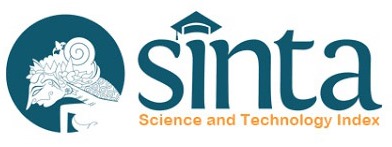Cembranoids Content of Soft Coral Sarcophyton from Acidified Environment at Volcano Island, Indonesia
Abstract
Keywords
Full Text:
PDFReferences
Anthony, K. R., Kline, D. I., Diaz-Pulido, G., Dove, S., & Hoegh-Guldberg, O. (2008). Ocean acidification causes bleaching and productivity loss in coral reef builders. PNAS. 105, 17442-17446.
Aratake, S., Tomura, T., Saitoh, S., Yokokura, R., Kawanishi, Y., Shinjo, R., Reimer, J.D., Tanaka, J. & Maekawa, H., (2012). Soft coral Sarcophyton (Cnidaria: Anthozoa: Octocorallia) species diversity and chemotypes. PLoSOne, 7(1), p.e30410.
ChemSpider. (2017). Search and share chemistry. Royal Society of Chemistry. [cited 2017 Jul 5]. Available from: http://www.chemspider.com.
Cao, F., Zhou, J., Xu, K.X., Zhang, M.Q., & Wang, C.Y. (2013). New cembranoid diterpene from the South China Sea soft coral Sarcophyton sp. Nat. Prod. Comm. 8(12), 1675-1678.
Cheng, S.Y., Wang, S.K., Chiou, S.F., Hsu, C.H., Dai, C.F., Chiang, M.Y., & Duh, C.Y. (2010). Cembranoids from the octocoral Sarcophyton ehrenbergi. J. Nat. Prod. 73(2), 197-203.
Crook, E.D., Potts, D., Rebolledo-Vieyra, M., Hernandez, L., Paytan, A. (2012). Calcifying coral abundance near low-pH springs: implications for future ocean acidification. Coral Reefs, 31, 239-245.
Dunn, J.G., Sammarco, P.W., & LaFleur, G.Jr. (2012). Effects of phosphate on growth and skeletal density in the Scleractinian coral Acropora muricata: A controlled experimental approach. J. Exp. Mar. Biol. Ecol. 411, 34–44.
Fabricius, K., & Alderslade, P. (2001). Soft corals and sea fans: a comprehensive guide to the tropical shallow water genera of the central-west Pacific, the Indian Ocean and the Red Sea. Townsville, Qld.: Australian Institute of Marine Science.
Fabricius, K.E., Langdon, C., Uthicke, S., Humphrey, C., Noonan, S., De’ath, G., & Lough J.M. (2011). Losers and winners in coral reefs acclimatized to elevated carbon dioxide concentrations. Nat. Clim. Change. 1, 165-169.
Farag, M.A., Porzel, A., Al-Hammady, M.A., Hegazy, M.E.F., Meyer, A., Mohamed, T.A., Westphal, H. & Wessjohann, L.A. (2016). Soft corals biodiversity in the Egyptian Red Sea: a comparative MS and NMR metabolomics approach of wild and aquarium grown species. J. Proteome Res. 15(4), 1274-1287.
Farag, M.A., Fekry, M.I., Al-Hammady, M.A., Khalil, M.N., El-Seedi, H.R., Meyer, A., Porzel, A., Westphal, H., & Wessjohann, L.A. (2017). Cytotoxic Effects of Sarcophyton sp. Soft Corals—Is There a Correlation to Their NMR Fingerprints? Mar Drugs. 15(7), 211.
Fleury, B.G., Coll, J.C., Sammarco, P.W., Tentori, E., & Duquesne, S. (2004). Complementary (secondary) metabolites in an octocoral competing with a scleractinian coral: Effects of varying nutrient regimes. J. Exp. Mar. Biol. Ecol. 303: 115-131.
Gabay, Y., Benayahu, Y., & Fine, M. (2013). Does elevated pCO2 affect reef octocorals? Ecol. Evol. 3, 465-473.
Gabay, Y., Fine, M., & Barkay, Z. (2014). Octocoral Tissue Provides Protection from Declining Oceanic pH. PloSONE. 9, e91553.
Inoue, S., Kayanne, H., Yamamoto, S., & Kurihara, H. (2013). Spatial community shift from hard to soft corals in acidified water. Nat Clim Change. 3, 683-687.
Iswani, S., Tohir, D. & Januar, H.I. (2014). Identification of Cytotoxic Compounds in Soft Coral Sarcophyton sp. from Panggang Island Water, Seribu Islands National Parks. Indones. J. Pharm. Sci. 12, 238-243.
Januar, H.I., Hendrarto, B., Chasanah, E. & Wright, A.D. (2011). Nephthea sp. Between Natural Products Production and Pressure from Local Environmental Stressors. J Marine Sci Res Dev. S8, 001.
Januar, H., Marraskuranto, E., Patantis, G. & Chasanah, E. (2012). LC-MS metabolomic analysis of environmental stressor impacts on the metabolite diversity in Nephthea spp. Chron. Young Sci. 3(1), 57-57.
Januar, H.I., Chasanah, E., Tapiolas, D.M., Motti, C.A., Liptrot, C.H., & Wright, A.D. (2015). Influence of anthropogenic pressures on the bioactivity potential of sponges and soft corals in the coral reef environment. Indones. Squalen Bull. Mar. Fish. Postharvest Biotech. 10(2), 51-59.
Januar, H.I., Zamani, N.P., Soedharma, D., & Chasanah, E. (2016a). Changes in soft coral Sarcophyton sp. Abundance and cytotoxicity at volcanic CO2 seeps in Indonesia. AIMS Environ. Sci. 3(2), 239-248.
Januar, H.I., Zamani, N.P., Soedharma, D., & Chasanah, E. (2016b). Logic Structure Determination (LSD) as a Computer Assisted Structure Elucidation (CASE) for Molecular Structure Determination of Cytotoxic Cembranoids from Soft Coral. Indones. Squalen Bull. Mar. Fish. Postharvest Biotech. 11(1), 1-6.
Januar, H.I., Zamani, N.P., Soedarma, D., Chasanah, E. & Wright, A.D. (2017a). Tropical coral reef coral patterns in Indonesian shallow water areas close to underwater volcanic vents at Minahasa Seashore, and Mahengetang and Gunung Api Islands. Mar. Ecol. 38(2), e12415.
Januar, H.I., Zamani, N.P., Soedharma, D., & Chasanah, E. (2017b). New cytotoxic cembranoid from indonesian soft coral Sarcophyton sp. Pharmacognosy res. 9(1), 65.
Januar, H.I., Zamani, N.P., Soedarma, D., & Chasanah, E. (2017c). Bioactive Cembranoid Composition in the Soft Coral Sarcophyton glaccum on the Response to Changing pH. Indones. J. Mar. Sci. 22(1), 25-30.
Kobayashi, M., Nakagawa, T., & Mitsuhashi, H. (1979). Marine terpenes and terpenoids. I. Structures of four cembrane-type diterpenes; sarcophytol-A, sarcophytol-A acetate sarcophytol-B, and sarcophytonin-A, from the soft coral, Sarcophyton glaucum. Chem. Pharm. Bull. 27(10), 2382-2387.
Kobayashi, M., & Osabe, K. (1989). Marine Terpenes and Terpenoid VII: Minor cembranoid derivatives, structurally related to the potent antitumor promoter Sarcophytol A, from the soft coral Sarcophyton glaucum. Chem. Pharm. Bull. 37(3), 631-636.
Koh, M., Iwanaga, T., Hatanaka, M., Nakano, A., Morihara, K., & Takemura, K. (2000). Distribution of sarcophytol A in soft coral of the Sarcophyton genus. Biosci. Biotech. Biochem. 64(4), 858-861.
Koop, K., Booth, D., Broadbent, A., Brodie, J., Bucher, D., Capone, D., Coll, J., Dennison, W., Erdman, M., Harrison, P., Hoegh-Guldberg, O., Hutching, P., Jones, G.B., Larkum, A.W.D., O’Neil, J., Steven, A., Tentori, E., Ward, S., Williamson, J., & Yellowless, D. (2001). ENCORE: The effect of nutrient enrichment on coral reefs. Synthesis of results and conclusions. Mar. Poll. Bull. 42(2), 91-120.
Lages, B.G., Fleury, B.G., Ferreira, C.E., & Pereira, R.C. (2006). Chemical defense of an exotic coral as invasion strategy. J. Exp. Mar. Biol. Ecol. 328(1), 127-135.
Lemke, P., Ren, R., Alley, I. (2007). The physical science basis. Contribution of Working Group I to the fourth assessment report of the Intergovernmental Panel on Climate Change. Clim. Change. 2007, 337-383.
Pham, N.B., Butler, M.S., & Quinn, R.J. (2002). Naturally occurring cembranes from an Australian Sarcophyton species. J. Nat. Prod. 65(8), 1147-1150.
Phan, C.S. & Vairappan, C.S., 2015. Isopropyl (ene)-type cembrane diterpene an important chemotaxonomical marker in Bornean soft coral Genus Sarcophyton. J. Tropical Biol. Consv. 12, 137-143.
Putra, M.Y., Saparhadi, A., Karim, F., Murniasih, T., & Swasono, R. T. (2017). Bioassay-Guided Isolation of an Antibacterial Compound from the Indonesian Soft Coral. Indones. Squalen Bull. Mar. Fish. Postharvest Biotech. 11(2), 53-58.
Slattery, M., Starmer, J. & Paul, V. (2001). Temporal and spatial variation in defensive metabolites of the tropical Pacific soft corals Sinularia maxima and S. polydactyla. Mar. Biol. 138(6), 1183-1193.
Tanaka, J., Yoshida, T., & Benayahu, Y. (2005). Chemical diversity of Sarcophyton soft corals in Okinawa. J. Japanese Coral Reef Soc. 7, 1-9.
Turon, X., Martí, R., & Uriz, M.J. (2009). Chemical bioactivity of sponges along an environmental gradient in a Mediterranean cave. Scientia Marina. 73(2), 387–397.
Wang, C.Y., Chen, A.N., Shao, C.L., Li, L., Xu, Y., & Qian, P.Y. (2011). Chemical constituents of soft coral Sarcophyton infundibuliforme from the South China Sea. Biochem. Systemat. Ecol. 39(4), 853-856.
Yang, B., Liu, J., Wang, J., Liao, S., & Liu, Y. (2015). Cytotoxic cembrane diterpenoids. In Handbook of Anticancer Drugs from Marine Origin (pp. 649-672). Springer International Publishing.
DOI: https://doi.org/10.15578/squalen.276
Refbacks
- There are currently no refbacks.
ISSN : 2089-5690(print), E-ISSN : 2406-9272(online)
This work is licensed under a Creative Commons Attribution-NonCommercial-ShareAlike 4.0 International License.










